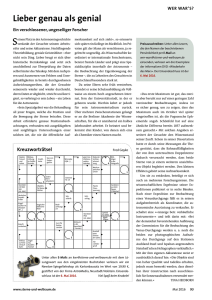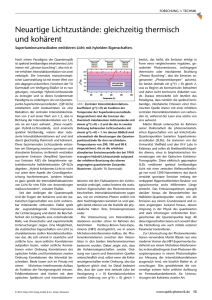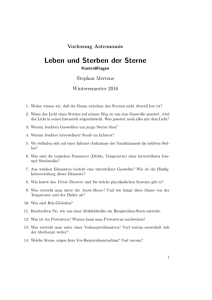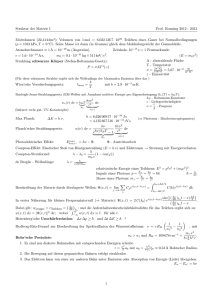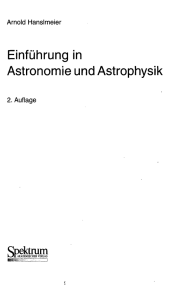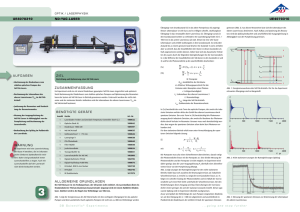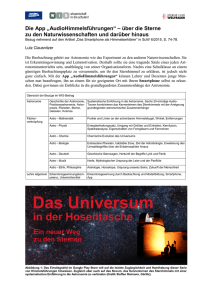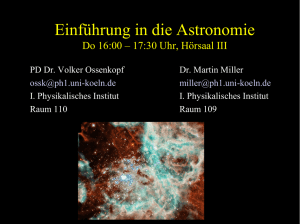Einführung in die Astronomie und Astrophysik II
Werbung
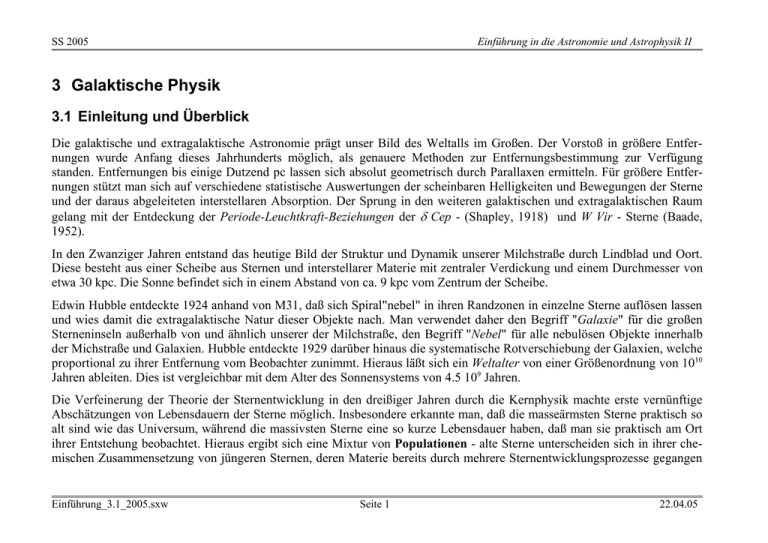
SS 2005 Einführung in die Astronomie und Astrophysik II 3 Galaktische Physik 3.1 Einleitung und Überblick Die galaktische und extragalaktische Astronomie prägt unser Bild des Weltalls im Großen. Der Vorstoß in größere Entfernungen wurde Anfang dieses Jahrhunderts möglich, als genauere Methoden zur Entfernungsbestimmung zur Verfügung standen. Entfernungen bis einige Dutzend pc lassen sich absolut geometrisch durch Parallaxen ermitteln. Für größere Entfernungen stützt man sich auf verschiedene statistische Auswertungen der scheinbaren Helligkeiten und Bewegungen der Sterne und der daraus abgeleiteten interstellaren Absorption. Der Sprung in den weiteren galaktischen und extragalaktischen Raum gelang mit der Entdeckung der Periode-Leuchtkraft-Beziehungen der δ Cep - (Shapley, 1918) und W Vir - Sterne (Baade, 1952). In den Zwanziger Jahren entstand das heutige Bild der Struktur und Dynamik unserer Milchstraße durch Lindblad und Oort. Diese besteht aus einer Scheibe aus Sternen und interstellarer Materie mit zentraler Verdickung und einem Durchmesser von etwa 30 kpc. Die Sonne befindet sich in einem Abstand von ca. 9 kpc vom Zentrum der Scheibe. Edwin Hubble entdeckte 1924 anhand von M31, daß sich Spiral"nebel" in ihren Randzonen in einzelne Sterne auflösen lassen und wies damit die extragalaktische Natur dieser Objekte nach. Man verwendet daher den Begriff "Galaxie" für die großen Sterneninseln außerhalb von und ähnlich unserer der Milchstraße, den Begriff "Nebel" für alle nebulösen Objekte innerhalb der Michstraße und Galaxien. Hubble entdeckte 1929 darüber hinaus die systematische Rotverschiebung der Galaxien, welche proportional zu ihrer Entfernung vom Beobachter zunimmt. Hieraus läßt sich ein Weltalter von einer Größenordnung von 1010 Jahren ableiten. Dies ist vergleichbar mit dem Alter des Sonnensystems von 4.5 109 Jahren. Die Verfeinerung der Theorie der Sternentwicklung in den dreißiger Jahren durch die Kernphysik machte erste vernünftige Abschätzungen von Lebensdauern der Sterne möglich. Insbesondere erkannte man, daß die masseärmsten Sterne praktisch so alt sind wie das Universum, während die massivsten Sterne eine so kurze Lebensdauer haben, daß man sie praktisch am Ort ihrer Entstehung beobachtet. Hieraus ergibt sich eine Mixtur von Populationen - alte Sterne unterscheiden sich in ihrer chemischen Zusammensetzung von jüngeren Sternen, deren Materie bereits durch mehrere Sternentwicklungsprozesse gegangen Einführung_3.1_2005.sxw Seite 1 22.04.05 SS 2005 Einführung in die Astronomie und Astrophysik II ist und die erheblich mehr Elemente schwerer als He enthalten. Entsprechend unterscheiden sich Farben-Helligkeits-Diagramme innerhalb der Milchstraße. Mit der Entdeckung der extraterrestrischen Radiostrahlung durch Jansky 1932 öffnete sich ein neues Fenster in den Kosmos. Neben der nichtthermischen Synchrotronstrahlung messen Radioteleskope die kühler, massereicher Molekülwolken und erlauben, deren Verteilung in der Milchstraße zu bestimmen. Es stellt sich heraus, das diese den Ort der frühen Entwicklung von Sternen markieren. Die zunehmende Winkelauflösung durch Radiointerferometer in den fünfziger Jahren gestatte die Entdeckung kompakter Radioquellen. Neben galaktischer Quellen - meist Supernovaüberreste - fand man in den Kernen bestimmter ("aktiver") Galaxien Quellen sehr starker Radioemission, meist einhergehend mit kollimierten Bündeln relativistischer Teilchen und Plasmas ("Jets"). Die Identifizierung extremer Radioemission bei hoher Rotverschiebung mit eher unauffälligen optischen Objekten (M. Schmidt, 1962/63) - Quasaren - legt nahe, daß zumindest im jungen Universum aktive Galaxienkerne eine große Rolle gespielt haben müssen. Die Erschließung anderer Spektralbereiche - der Röntgenbereich durch Weltrauminstrumente und der Infrarotbereich durch moderne Detektoren an bodengebundenen und Weltraum-Teleskopen - haben ihren Teil an der noch anhaltenden Welle neuer Entdeckungen. Einführung_3.1_2005.sxw Seite 2 22.04.05 SS 2005 Einführung in die Astronomie und Astrophysik II Die Milchstraße in verschiedenen Spektralbereichen (siehe http://adc.gsfc.nasa.gov/mw/) 408 MHz 1.4 GHz 115 GHz 12, 60, 100 µm 2.5 µm 0.6 µm 1 keV 100 MeV Einführung_3.1_2005.sxw Seite 3 22.04.05 SS 2005 Spektralbereich Radiokontinuum ν = 408 MHz λ = 740 mm Einführung in die Astronomie und Astrophysik II Strahlungsquellen Heißes Gas, Streuung freier Elektronen, Synchrotronstrahlung Intensity of radio continuum emission from high-energy charged particles in the Milky Way, from surveys with ground-based radio telescopes (Jodrell Bank Mark I and Mark IA, Bonn 100-meter, and Parkes 64meter). At this frequency, most of the emission is from electrons moving through the interstellar magnetic field at nearly the speed of light. Shock waves from supernova explosions accelerate electrons to such high speeds, producing especially intense radiation near these sources. Emission from the supernova remnant Cas A near 110° longitude is so intense that the diffraction pattern of the support legs for the radio receiver on the telescope is visible as a cross shape. 21-cm Linie ν = 1.4 GHz λ = 210 mm Atomarer Wasserstoff (Hyperfeinstruktur), normales interstellares Medium, Gas 115 GHz – Linie ν = 115 GHz λ = 2.6 mm Molekularer Wasserstoff, (J=1-0 Übergang von CO als tracer), kühles interstellares Medium Einführung_3.1_2005.sxw Column density of atomic hydrogen,derived on the assumption of optically thin emission, from radio surveys of the 21-cm transition of hydrogen. The 21-cm emission traces the "cold and warm" interstellar medium, which on a large scale is organized into diffuse clouds of gas and dust that have sizes of up to hundreds of light-years. Most of the image is based on the Leiden-Dwingeloo Survey of Galactic Neutral Hydrogen using the Dwingeloo 25-m radio telescope; the data were corrected for sidelobe contamination in collaboration with the University of Bonn. Column density of molecular hydrogen inferred from the intensity of the J =1-0 spectral line of carbon monoxide, a standard tracer of the cold, dense parts of the interstellar medium. Such gas is concentrated in the spiral arms in discrete "molecular clouds." Most molecular clouds are sites of star formation. The molecular gas is pre-dominantly H2, but H2 is difficult to detect directly at interstellar conditions and CO, the second most abundant molecule, is observed as a surrogate. The column densities were derived on the assumption of a constant proportionality between the column density of H2 and the intensity of the CO emission. Seite 4 22.04.05 SS 2005 Einführung in die Astronomie und Astrophysik II Thermisches Infrarot ν = 3 - 25 THz λ = 12, 60, 100 µm Thermische Strahlung warmer interstellare Materie, Sternentstehungsgebiete, Staub Nahes Infrarot ν = 120 THz λ = 2.5 µm Kühle Sterne mit geringer Masse (IM ist transparent bei diesen Wellenlängen) Optisch ν = 120 THz λ = 0.6 µm Sterne, insterstellare Materie als Dunkelwolken Intensity of visible (0.4 - 0.6 micron) light from a photographic survey. Due to the strong obscuring effect of Einführung_3.1_2005.sxw Composite mid-and far-infrared intensity observed by the Infrared Astronomical Satellite (IRAS) in 12, 60, and 100 micron wavelength bands. The images are encoded in the blue, green, and red color ranges, respectively. Most of the emission is thermal, from interstellar dust warmed by absorbed starlight, including star-forming regions embedded in interstellar clouds. The display here is a mosaic of IRAS Sky Survey Atlas images. Emission from interplanetary dust in the solar system, the "zodiacal emission," was modeled and subtracted in the production of the Atlas. Composite near-infrared intensity observed by the Diffuse Infrared Background Experiment (DIRBE) instrument on the Cosmic Background Explorer (COBE) in the 1.25, 2.2, and 3.5 micron wavelength bands. The images are encoded in the blue, green, and red color ranges, respectively. Most of the emission at these wavelengths is from relatively cool giant K stars in the disk and bulge of the Milky Way. Interstellar dust does not strongly obscure emission at these wavelengths; the maps trace emission all the way through the Galaxy, although absorption in the 1.25 micron band is evident toward the Galactic center region. interstellar dust,the light is primarily from stars within a few thousand light-years of the Sun, nearby on the scale of the Milky Way. The widespread bright red regions are produced by glowing, low-density gas. Dark patches are due to absorbing clouds of gas and dust, which are evident in the Molecular hydrogen and Infrared maps as emission regions. Stars differ from one another in color, as well as mass, size and luminosity. Interstellar dust scatters blue light preferentially, reddening the starlight somewhat relative to its true color and producing a diffuse bluish glow. This scattering, as well as absorption of some of the light by dust, also leaves the light diminished in brightness. The panorama was assembled from sixteen wide-angle photographs taken by Dr. Axel Mellinger using a standard 35-mm camera and color negative film. The exposures were made between July 1997 and January 1999 at sites in the United States, South Africa, and Germany. The image processing and mosaicing procedures are described in the document cited below. Image courtesy of A. Mellinger. Seite 5 22.04.05 SS 2005 Einführung in die Astronomie und Astrophysik II Röntgen EPh = 1 kev λ = 1.4 nm Heißes, durch Schockwellen aufgeheiztes Gas, insterstellare Materie als Dunkelwolken Gamma EPh = 100 Mev λ = 14 fm Kollision kosmischer Strahlung an Protonen, Supernova-Reste Einführung_3.1_2005.sxw Composite X-ray intensity observed by the Position-Sensitive Proportional Counter (PSPC) instrument on the Röntgen Satellite (ROSAT). Images in three broad, soft X-ray bands centered at 0.25 , 0.75, and 1.5 keV are encoded in the red, green, and blue color ranges, respectively. In the Milky Way, extended soft X-ray emission is detected from hot, shocked gas. At the lower energies especially, the interstellar medium strongly absorbs X-rays, and cold clouds of interstellar gas are seen as shadows against background X-ray emission. Color variations indicate variations of absorption or of the temperatures of the emitting regions. The black regions indicate gaps in the ROSAT survey. Intensity of high-energy gamma-ray emission observed by the Energetic Gamma-Ray Experiment Telescope (EGRET) instrument on the Compton Gamma-Ray Observatory (CGRO). The image includes all photons with energies greater than 300 MeV. At these extreme energies, most of the celestial gamma rays originate in collisions of cosmic rays with hydrogen nuclei in interstellar clouds. The bright, compact sources near Galactic longitudes 185°, 195°, and 265° indicate high-energy phenomena associated with the Crab, Geminga, and Vela pulsars, respectively. Seite 6 22.04.05
